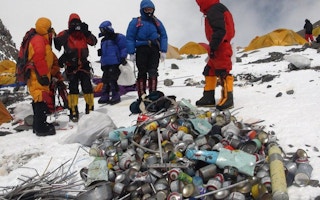Six decades after the first conquest of the world’s highest peak, tons of rubbish and human waste abandoned by hundreds of Mount Everest climbers is starting to raise a stink.
Nepal is cracking down on the mountaineers who seek to emulate the 1953 feat of Sir Edmund Hillary and Sherpa Tenzing Norgay, in the process giving the 8,850-metre (29,035-foot) peak the dubious honor of being the world’s highest garbage dump.
About 300 mountaineers and as many Sherpa guides battle the elements on Everest’s icy slopes during the annual climbing season, which begins in March and runs until May.
But in the absence of toilets climbers must squat in the open or hunker down behind rocks to do their business.
Now Nepal has threatened stricter enforcement of penalties to persuade climbers to clean up after themselves and carry litter back to base camp.
A 2014 rule for a garbage deposit of $4,000 to be forfeited by any expedition from which a climber fails to bring back 8 kg (17.6 lbs) of trash and human waste, will be strictly enforced this year, a tourism official said.
Human excrement is a bigger problem than the oxygen bottles, torn tents, broken ladders, and cans or wrappers teams left behind, said Ang Tshering Sherpa, chief of the Nepal Mountaineering Association.
“Discarded in ice pits, the human waste remains under the snow,” Sherpa told reporters on Tuesday. “When washed down by glaciers (when the snow melts), it comes out in the open.”
Human waste piling up over decades gave off an “unpleasant odor” and posed a health hazard to people dependent on water from rivers fed by the region’s melting glaciers, Sherpa said.
Climbers said it was hard to estimate how much human waste remained frozen under the snow, but they agreed the mountain’s surface was much cleaner after the NMA’s monitoring efforts.
Eco-Everest clean-up expeditions led by Dawa Steven Sherpa each year since 2008 have retrieved 15,000 kg (33,070 lbs) of trash, but there are no estimates of garbage left behind.
Some 4,000 climbers have scaled Mount Everest so far. Snow shrouds the bodies of at least 260 who died trying.
In 2012, Nepali artists sculpted into works of art 1.5 metric tons (1.7 tons) of trash taken from Mount Everest, as part of an awareness campaign to keep the summit pristine.








